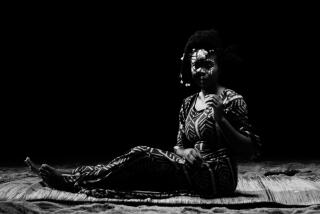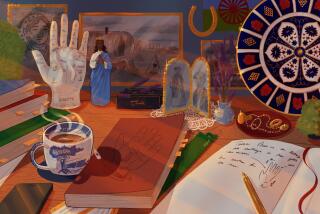KINGS, GODS & SPIRITS FROM AFRICAN MYTHOLOGY by Jan Knappert; illustrated by Francesca Pelizzoli (Schocken: $16.95; 92 pp.; age 12-up).
- Share via
Critics of The TV Habit often say we’d be a better society without it, or at least a more creative one tuned into reading instead of reruns. If our evenings were like those of primitive cultures--unplugged--we’d probably spawn artistic rituals that would last generations.
“Among the greatest of all is the art of storytelling,” Jan Knappert says in this new edition of Schocken’s World Mythology Series. In the African countryside where few homes have lamps and “of course there is no television,” people entertain each other with stories after sunset. “The storyteller has his eyes and ears open . . . he knows the customs of the tribe and the importance of passing on traditional values and history.” Knappert, an expert on the folklore and languages of Africa, shares dozens of these tales, their origins and their social importance today. A full-color map, elegant line drawings and 12 double-spread paintings by Francesca Pelizzoli make this a handsome volume.
“The Golden Stool” tells how men in regions of West Africa carry a low, wooden seat with them everywhere so they will never be embarrassed by having to search for a place to sit during meetings. They believe that part of the owner’s spirit lives in his stool. In fact, today in the palace of Kumasi, people can see an ancient royal stool that contains “the soul of the Ashanti nation,” a symbol of unity.
“The Ogre Who Ate People” relates how a deceived bride could have avoided heartbreak had she listened to her elders. “The Fox and the Crow” and “Anansi the Spider” are trickster tales similar to Br’er Rabbit and are still told in daily conversations as a way of giving advice without hurting anyone’s feelings.
The only real flaw is the book’s opening sentence. Four boring statistics give it an encyclopedic air, which could discourage some young readers.
More to Read
Sign up for our Book Club newsletter
Get the latest news, events and more from the Los Angeles Times Book Club, and help us get L.A. reading and talking.
You may occasionally receive promotional content from the Los Angeles Times.










